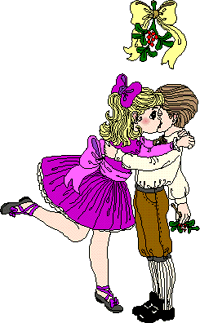


Giving a Gift.



When we give gifts to our loved ones at Christmas, we're continuing a tradition that began when the Three Kings visited the Christ child in Bethlehem. The Three Wise Men brought gifts of gold, frankincense and myrrh to the baby Jesus, as a tribute to the newborn king. And while the three travellers had great wealth, it's believed that even poor people brought presents to the baby Jesus. In one story often told, a young boy wanted desperately to see the baby. So he went to see Him carrying his one and only possession -- a small drum, which he played softly to the infant's delight. Gift-giving was also a part of many ancient pre-Christmas festivals. But since the early Christians didn't want their religion to be associated with pagan festivals, they criticized gift-giving as a pagan ritual. So it didn't become part of the Christmas tradition until several centuries after the birth of Christ. It finally began to take hold in the Middle Ages. Nowadays, most families put their presents under a decorated Christmas tree, and open them on the morning of December 25th.
Sending Cards




It just wouldn't feel like Christmas without a good case of writer's cramp. You know, the tiring but worthwhile practice of writing and sending Christmas cards to friends and relatives. It's something we've been doing for more than a century and a half at Christmas time. The first Christmas cards were sent to friends by Sir Henry Cole in England in 1843. They were designed by British artist J.C. Horsely, depicting good deeds, such as clothing the naked and feeding the hungry. The creation of Britain's penny post made it affordable for many people to exchange holiday greetings by mail. The first American cards were made in 1875 by German-born printer Louis Prang. He later helped popularize the cards by holding contests for the best designs. The folks at Hallmark cards estimate that each year as many as two billion Christmas cards are exchanged among friends. It's easily the busiest card-buying time of the year.
Mistletoe

It happens at most every Christmas party -- somebody stands in a doorway, (me!) beneath the mistletoe, just waiting for the right opportunity. We've been doing it for centuries. We haven't always been kissing under the mistletoe, but people have been long accustomed to greeting one another below the plant with the white berries. In ancient Britain, mistletoe was thought to be sacred. Some 200 years before Christ's birth, the Druids celebrated the start of winter by gathering mistletoe and hanging the plant in their homes to ensure a good start to the year. The idea of kissing underneath mistletoe had its start in the Norse myths. A goddess gave her son a charm of mistletoe to protect him. Instead, it had the opposite effect, and he was slain by an arrow made of mistletoe. The goddess' tears are said to have formed the mistletoe's white berries. She brought her son back to life and vowed to kiss anyone who rested beneath the plant. And part of the fun, according to tradition, is that you can't refuse a kiss from anyone who catches you there!!......so you have all been warned. ha ha ha !
Santa Claus/Father Christmas



He's been a part of the legend of Christmas since the fourth century. But he hasn't always been thought of as a jolly old elf. The earliest tales of Santa Claus come from what was then Asia Minor in the fourth century. St. Nicholas was born in a seaport town, and travelled to Egypt and Palestine as a young man. And his practice of giving gifts to needy children made him welcome wherever he visited. Many years later, the name St. Nicholas became splintered into many variations among the Protestant churches of Europe. And in Europe, many children celebrate St. Nicholas Day by hanging up their stockings the night before December sixth. In America, Santa Claus is seen as a jolly man with white whiskers and an infectious laugh. That image dates back to the 1820s and the poem, "A Visit From St. Nicholas." In England we have the same beleifs as America only we call him Father Christmas.
Boxing Day (December 26th)
|
|
|
The day after Christmas Day is known as Boxing Day, in England, Wales, parts of Canada, and in some other countries of the Commonwealth of Nations. Boxing Day was named after the tradition of opening the alms boxes which were placed in churches over the Christmas season. The contents were distributed amongst the poor of the parish. . Traditionally,also, on that day the gentry would give presents, generally of money, to servants, tradespeople, and others of humble life. These presents came to be known as Christmas boxes.
December 26 is also known as the Feast of St Stephen.
It is often a day of outdoor sports and horse racing and hunting. Only in the last century
however has it become a holiday. By having Christmas Day and Boxing Day as holidays this allowed many people to
take trips but also rejoin family members, which I think has encouraged the tradition of families getting together at
Christmas time.